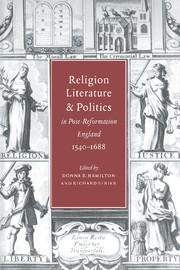Book contents
- Frontmatter
- Contents
- List of contributors
- Introduction
- 1 Sir John Oldcastle as symbol of Reformation historiography
- 2 The “sacred hunger of ambitious minds”: Spenser's savage religion
- 3 Subversive fathers and suffering subjects: Shakespeare and Christianity
- 4 Kneeling and the body politic
- 5 Donne and the politics of devotion
- 6 Catholic, Anglican or puritan? Edward Sackville, fourth Earl of Dorset, and the ambiguities of religion in early Stuart England
- 7 Crucifixion or apocalypse? Refiguring the Eikon Basilike
- 8 Marvell, sacrilege, and Protestant historiography: contextualizing “Upon Appleton House”
- 9 Entering The Temple: women, reading, and devotion in seventeenth-century England
- 10 Contextualizing Dryden's Absalom: William Lawrence, the laws of marriage, and the case for King Monmouth
- 11 Reformation in the Restoration Crisis, 1679–1682
- 12 Shadwell's dramatic trimming
- Index
7 - Crucifixion or apocalypse? Refiguring the Eikon Basilike
Published online by Cambridge University Press: 16 October 2009
- Frontmatter
- Contents
- List of contributors
- Introduction
- 1 Sir John Oldcastle as symbol of Reformation historiography
- 2 The “sacred hunger of ambitious minds”: Spenser's savage religion
- 3 Subversive fathers and suffering subjects: Shakespeare and Christianity
- 4 Kneeling and the body politic
- 5 Donne and the politics of devotion
- 6 Catholic, Anglican or puritan? Edward Sackville, fourth Earl of Dorset, and the ambiguities of religion in early Stuart England
- 7 Crucifixion or apocalypse? Refiguring the Eikon Basilike
- 8 Marvell, sacrilege, and Protestant historiography: contextualizing “Upon Appleton House”
- 9 Entering The Temple: women, reading, and devotion in seventeenth-century England
- 10 Contextualizing Dryden's Absalom: William Lawrence, the laws of marriage, and the case for King Monmouth
- 11 Reformation in the Restoration Crisis, 1679–1682
- 12 Shadwell's dramatic trimming
- Index
Summary
The English regicides who tried and condemned their reigning monarch as a “tyrant,” “traitor,” “murderer,” and “public enemy” could not have chosen a worse day than January 30, 1649 for his public execution. Whether by unlucky coincidence or divine providence, the second lesson appointed for that day in the Book of Common Prayer was the 27th chapter of Matthew's Gospel, on the trial and crucifixion of Christ. According to the royalists, the biblical narrative inevitably shaped the observer's understanding of the execution: “we could not but conceive, that the murther then to be acted, was like unto that which in the chapter is described.” Speaking from the scaffold, Charles encouraged this comparison; he forgave his accusers and declared himself “the martyr of the people” (Trial, pp. 141–2). Although the regicides could cut off the king's scaffold performance with one blow of the executioner's axe, the myth of the execution as the crucifixion reenacted proved much more durable. The spectacle of Charles I's Christlike martyrdom lived on in the most successful piece of royalist propaganda to issue from the English Civil Wars: the Eikon Basilike, commonly known as the “King's Book.”
In the Eikon Basilike, Charles does not merely claim a divine right to rule, but also a more personal kind of divinity: he strives “to imitate [his] crucified Redeemer” in “suffering for righteousness' sake” (EB, pp. 157;176).
- Type
- Chapter
- Information
- Publisher: Cambridge University PressPrint publication year: 1996
- 9
- Cited by



